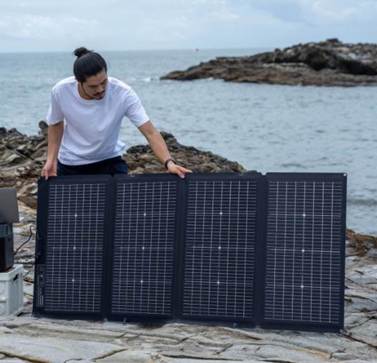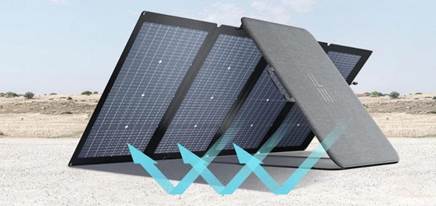Solar energy offers a fantastic alternative to fossil fuels, harnessing the power of the sun to generate electricity. But what happens when the sky is overcast? Do solar panels still work on cloudy days? This article delves into the science behind solar panels and their performance in less-than-ideal weather conditions. We’ll also offer practical tips on how to maximize the efficiency of your solar panels when the skies are gray.

The Science Behind Solar Panel Efficiency in Overcast Conditions
Understanding how solar panels function in cloudy weather starts with the basics of photovoltaic technology. While it’s true that direct sunlight is optimal, it’s important to know that solar panels are designed to capture even the scattered, diffuse light that filters through clouds.
Photovoltaic Cells and Light Absorption
Solar panels consist of photovoltaic (PV) cells, which convert sunlight into electricity. These cells are designed to capture light particles or photons. When photons hit the PV cells, they knock electrons loose, creating an electric current. This current is then harnessed and converted into usable electricity. While PV cells are optimized for direct sunlight, they can still absorb diffuse light, which is the scattered light that penetrates through clouds.
Impact of Diffuse vs. Direct Sunlight
Direct sunlight is more efficient for solar panels, providing a higher intensity of light that leads to better performance. However, solar panels can still operate under diffuse sunlight, which is light that has been scattered by particles in the atmosphere and is more prevalent on cloudy days. Although the efficiency drops, modern solar panels are designed to optimize the absorption of both direct and diffuse sunlight, enabling them to function even when the sun isn’t directly visible.
Factors Influencing Solar Panel Performance on Cloudy Days
Understanding the factors that impact solar panel performance in cloudy weather helps set realistic expectations for energy production. These factors include cloud density, panel technology, and your geographic location.
Cloud Density and Type
The thickness and type of clouds play a significant role in solar panel efficiency. Thick, dense clouds can significantly reduce the amount of light that reaches the panels, while lighter, thinner clouds allow more light to pass through. Stratus clouds, which form a uniform grey layer, can limit solar power more than cumulus clouds, which are fluffier and allow more diffuse light to reach the ground. Monitoring weather patterns can help you understand when your solar panels might be underperforming.
Panel Technology and Quality
The type and quality of solar panels also directly impact their performance on cloudy days. High-efficiency panels, often made with monocrystalline cells, can better capture both direct and diffuse light compared to lower-efficiency alternatives. Premium panels with advanced technology and higher conversion efficiencies ensure that you get the most power output even under less favorable weather conditions.
Geographical Location and Weather Patterns
Where you live plays a vital role in the effectiveness of your solar panels. Regions with consistent sunlight will naturally yield better solar energy production, but areas known for frequent cloudy weather can still benefit from solar power. Understanding your geographical location and local weather patterns can help you set realistic expectations and optimize panel placement for maximum efficiency.

Maximizing Solar Panel Efficiency in Cloudy Weather
Even in cloudy conditions, you can take several steps to improve the performance of your solar panels. From choosing the right technology to ensuring proper panel orientation, these strategies can make a significant difference in energy generation.
Choosing the Right Solar Panel Technology
Investing in high-efficiency solar panels that use advanced technologies like PERC (Passivated Emitter Rear Cell) or bifacial cells can significantly improve performance in cloudy conditions. These technologies are designed to capture more light and convert it into electricity more efficiently, ensuring that even diffuse light contributes effectively to your energy production.
Optimal Panel Orientation and Tilt
Proper placement and orientation of your solar panels can make a substantial difference. Panels should be installed at an angle that maximizes sunlight exposure, even on cloudy days. The optimal tilt angle varies depending on your location and the time of year, but a general rule is to set your panels at a tilt equal to your latitude. South-facing panels typically receive the most sunlight in the Northern Hemisphere, while north-facing panels are preferable in the Southern Hemisphere.
Regular Maintenance and Cleaning
Keeping your solar panels clean and well-maintained ensures that they can absorb as much light as possible. Regular cleaning to remove dirt, dust, and debris will help maintain their efficiency. Additionally, inspecting your system for any signs of damage or wear can prevent performance issues and ensure that your solar panels continue to operate effectively, regardless of the weather.
Conclusion
Solar panels are a reliable and sustainable energy source, even on cloudy days. While their efficiency may decrease in overcast conditions, modern technological advancements ensure that they continue to generate electricity. By understanding the science behind solar panel operation, considering factors that influence performance, and implementing strategies to maximize efficiency, you can make the most of your solar investment, rain or shine.


